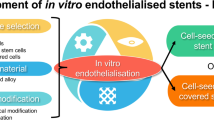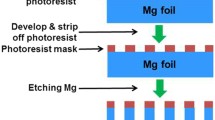Abstract
Traditional in vitro evaluation criteria of magnesium (Mg)-based stents cannot reflect the degradation process in vivo, due to the interdependence and interference between biodegradable properties and bioenvironment. The current direct and indirect evaluation approaches of in vitro biocompatibility do not have a hydrodynamic environment and vascular biological structure existing in vivo. Herein, we designed a vascular bioreactor to provide an ex vivo culture environment for vessels, which reveals the degradation behavior of Mg–Zn–Mn stent and the effect of its degradation on cells. We reported that rabbit carotid arteries could maintain native morphology and viability in the bioreactor under the best condition within a flow rate of 5.4 mL min−1 and a culture time of one week. With this culture condition, Mg–Zn–Mn stents were implanted into the arteries in the bioreactors and compared with in vivo rabbit models. The arteries maintained cell survival in the bioreactor, but the cell attachment was absent on the stent struts, associated with a fast degradation. Conversely, the stents achieved a rapid and complete endothelialization in vivo for two weeks. This study could provide a correlation and difference of the degradation behavior and cellular response to the degradation of Mg-based stent between ex vivo and in vivo approaches.






Similar content being viewed by others
References
Aneja, R., C. Yates, S. Josson, L. Chung, and H. Joshi. EM044, a novel noscapinoid induces apoptosis in prostate cancer cells while sparing the normal stroma. Mol. Cancer Ther. 6:32–34, 2007.
Bjork, J. W., and R. T. Tranquillo. Transmural flow bioreactor for vascular tissue engineering. Biotechnol. Bioeng. 104:1197–1206, 2009.
Doepke, A., J. Kuhlmann, X. Guo, R. T. Voorhees, and W. R. Heineman. A system for characterizing Mg corrosion in aqueous solutions using electrochemical sensors and impedance spectroscopy. Acta Biomater. 9:9211–9219, 2013.
Echeverry-Rendon, M., J. P. Allain, S. M. Robledo, F. Echeverria, and M. C. Harmsen. Coatings for biodegradable magnesium-based supports for therapy of vascular disease: a general view. Mater. Sci. Eng. C. 102:150–163, 2019.
Ellis, S. G., D. J. Kereiakes, D. C. Metzger, R. P. Caputo, D. G. Rizik, P. S. Teirstein, M. R. Litt, A. Kini, A. Kabour, S. O. Marx, J. J. Popma, R. M. Greevy, Z. Zhang, C. Simonton, and G. W. Stone. Everolimus-eluting bioresorbable scaffolds for coronary artery disease. N. Engl. J. Med. 373:1905–1915, 2015.
Erbel, R., C. D. Mario, J. Bartunek, J. Bonnier, B. De Bruyne, F. R. Eberli, P. Erne, M. Haude, B. Heublein, M. Horrigan, C. Ilsley, D. Böse, J. Koolen, T. F. Lüscher, N. Weissman, and R. Waksman. Temporary scaffolding of coronary arteries with bioabsorbable magnesium stents: a prospective, non-randomised multicentre trial. Lancet. 369:1869–1875, 2007.
Gu, X., Y. Zheng, Y. Cheng, S. Zhong, and T. Xi. In vitro corrosion and biocompatibility of binary magnesium alloys. Biomaterials. 30:484–498, 2009.
Haude, M., R. Erbel, P. Erne, S. Verheye, P. Vermeersch, H. Degen, D. Bose, R. Waksman, N. Weissman, F. Prati, and J. Koolen. Three year clinical and imaging data of the paclitaxel-eluting absorbable magnesium scaffold (Dreams) from the Biosolve-I study. Circulation. 130:A11993–A11993, 2014.
Haude, M., H. Ince, A. Abizaid, R. Toelg, P. A. Lemos, C. Von Birgelen, E. H. Christiansen, W. Wijns, F. J. Neumann, C. Kaiser, E. Eeckhout, S. T. Lim, J. Escaned, H. M. Garcia-Garcia, and R. Waksman. Safety and performance of the second-generation drug-eluting absorbable metal scaffold in patients with de-novo coronary artery lesions (BIOSOLVE-II): 6 month results of a prospective, multicentre, non-randomised, first-in-man trial. Lancet. 387:31–39, 2016.
Haude, M., H. Ince, S. Kische, A. Abizaid, R. Tölg, P. A. Lemos, N. M. Van Mieghem, S. Verheye, C. Von Birgelen, E. H. Christiansen, W. Wijns, H. M. Garcia-Garcia, and V. Waksman. Sustained safety and clinical performance of a drug-eluting absorbable metal scaffold up to 24 months: pooled outcomes of BIOSOLVE-II and BIOSOLVE-III. Eurointervention. 13:432–439, 2017.
Huang, A. H., and L. E. Niklason. Engineering biological-based vascular grafts using a pulsatile bioreactor. JOVE. 52:1–7, 2011.
Iqbal, J., Y. Onuma, J. Ormiston, A. Abizaid, R. Waksman, and P. Serruys. Bioresorbable scaffolds: rationale, current status, challenges, and future. Eur. Heart J. 35:765–776, 2013.
Jinnouchi, H., S. Torii, A. Sakamoto, F. D. Kolodgie, R. Virmani, and A. V. Finn. Fully bioresorbable vascular scaffolds: lessons learned and future directions. Nat. Rev. Cardiol. 16:286–304, 2019.
Kereiakes, D. J., S. G. Ellis, C. Metzger, R. P. Caputo, D. G. Rizik, P. S. Teirstein, M. R. Litt, A. Kini, A. Kabour, S. O. Marx, J. J. Popma, R. M. Greevy, Z. Zhang, C. Simonton, and G. W. Stone. 3-year clinical outcomes with everolimus-eluting bioresorbable coronary scaffolds. J. Am. Coll. Cardiol. 70:2852–2862, 2017.
King, A. D., N. Birbilis, and J. R. Scully. Accurate electrochemical measurement of magnesium corrosion rates; a combined impedance, mass-loss and hydrogen collection study. Electrochim. Acta. 121:394–406, 2014.
Laukart, J. Fluid-flow handling in bioprocess operations. Genet. Eng. News. 23:1–50, 2003.
Loos, A., R. Rohde, A. Haverich, and S. Barlach. In vitro and in vivo biocompatibility testing of absorbable metal stents. Macromol. Symp. 253:103–108, 2007.
Ma, J., N. Zhao, L. Betts, and D. H. Zhu. Bio-adaption between magnesium alloy stent and the blood vessel: a review. J. Mater. Sci. Technol. 32:815–826, 2016.
Marco, I., F. Feyerabend, R. Willumeit-Roemer, and O. Van der Biest. Degradation testing of Mg alloys in Dulbecco’s modified eagle medium: influence of medium sterilization. Mater. Sci. Eng. C. 62:68–78, 2016.
Mochizuki, A., C. Yahata, and H. Takai. Cytocompatibility of magnesium and AZ31 alloy with three types of cell lines using a direct in vitro method. J. Mater. Sci. Mater. M. 27:145.1–145.10, 2016.
Sivarapatna, A., M. Ghaedi, A. V. Le, J. J. Mendez, Y. Qyang, and L. E. Niklason. Arterial specification of endothelial cells derived from human induced pluripotent stem cells in a biomimetic flow bioreactor. Biomaterials. 53:621–633, 2015.
Waksman, R., R. Pakala, P. K. Kuchulakanti, R. Baffour, D. Hellinga, R. Seabron, F. O. Tio, E. Wittchow, S. Hartwig, C. Harder, R. Rohde, B. Heublein, A. Andreae, K. H. Waldmann, and A. Haverich. Safety and efficacy of bioabsorbable magnesium alloy stents in porcine coronary arteries. Catheter. Cardio. Inte. 68:607–617, 2006.
Wang, J., Y. Jang, G. Wan, V. Giridharan, G. L. Song, Z. Xu, Y. Koo, P. Qi, J. Sankar, N. Huang, and Y. Yun. Flow-induced corrosion of absorbable magnesium alloy: in-situ and real-time electrochemical study. Corros. Sci. 104:277–289, 2016.
Wang, J., C. E. Smith, J. Sankar, Y. Yun, and N. Huang. Absorbable magnesium-based stent: physiological factors to consider for in vitro degradation assessments. Regen. Biomater. 2:59–69, 2015.
Wang, J., L. Liu, Y. Wu, M. F. Maitz, Z. Wang, Y. Koo, A. Zhao, J. Sankar, D. Kong, N. Huang, and Y. Yun. Ex vivo blood vessel bioreactor for analysis of the biodegradation of magnesium stent models with and without vessel wall integration. Acta Biomater. 50:546–555, 2017.
Wang, J., V. Giridharan, V. Shanov, Z. Xu, B. Collins, L. White, Y. Jang, J. Sankar, N. Huang, and Y. Yun. Flow-induced corrosion behavior of absorbable magnesium-based stents. Acta Biomater. 10:5213–5223, 2014.
Yang, L., N. Hort, R. Willumeit, and F. Feyerabend. Effects of corrosion environment and proteins on magnesium corrosion. Corros. Eng. Sci. Techn. 47:335–339, 2012.
Ye, C., J. Wang, A. Zhao, D. He, M. F. Maitz, N. Zhou, and N. Huang. Atorvastatin eluting coating for magnesium-based stents: control of degradation and endothelialization in a microfluidic assay and in vivo. Adv. Mater. Technol. 5:1–11, 2020.
Zhang, H., W. Deng, X. Wang, S. Wang, J. Ge, and E. Toft. Solely abluminal drug release from coronary stents could possibly improve reendothelialization. Catheter. Cardio. Inte. 88:E59–E66, 2016.
Zhang, J., H. Li, W. Wang, H. Huang, J. Pei, H. Qu, G. Yuan, and Y. Li. The degradation and transport mechanism of a Mg-Nd-Zn-Zr stent in rabbit common carotid artery: a 20-month study. Acta Biomater. 69:372–384, 2018.
Zhao, N., and D. Zhu. Endothelial responses of magnesium and other alloying elements in magnesium-based stent materials. Metallomics. 7:118–128, 2014.
Acknowledgments
This study was supported by the National Natural Science Foundation of China (NSFC 81771988 and 81330031), National Key Research and Development Project (YFB 0702500), and Sichuan Science and Technology Project (20GJHZ0268).
Author contributions
NLZ performed most of the bioreactor condition measurements, ex vivo and in vivo experiments, analyzed the data and prepared the manuscript with help from all authors. PL designed and assembled the bioreactor, preliminarily explored the experimental conditions. HQ revised the manuscript. JW is co-corresponding author in this manuscript, and she is the first author’s advisor. In this work, she conceived the idea, supervised the study, and guided the manuscript. ASZ is the corresponding author in this manuscript, and she is the first author’s co-advisor. In this work, she guided the experimental process.
Conflict of interest
The authors declare no conflict of interest.
Author information
Authors and Affiliations
Corresponding authors
Additional information
Associate Editor Smadar Cohen oversaw the review of this article.
Publisher's Note
Springer Nature remains neutral with regard to jurisdictional claims in published maps and institutional affiliations.
Rights and permissions
About this article
Cite this article
Zhou, N., Li, P., Qiu, H. et al. Comparison of in Vascular Bioreactors and In Vivo Models of Degradation and Cellular Response of Mg–Zn–Mn Stents. Ann Biomed Eng 49, 1551–1560 (2021). https://doi.org/10.1007/s10439-020-02699-3
Received:
Accepted:
Published:
Issue Date:
DOI: https://doi.org/10.1007/s10439-020-02699-3




